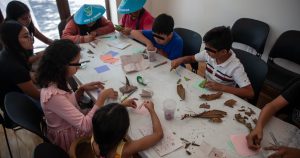In general, the researchers found that the best-performing children were those who had used their fingers in the past, but no longer relied on them.
MADRID 20 Nov. (EUROPA PRESS).- Los children that have the fingers between the four and the six and a half years they have better addition skills at age seven than those who do not use their fingers, suggesting that count on fingers is an important step towards math skills more advanced, according to research from the University of Lausanne in Switzerland, published by the American Psychological Association in ‘Developmental Psychology’.
“Counting on fingers is not only a tool for immediate success in young children, but a way to support the development of advanced abstract arithmetic skills,” reflects lead author Catherine Thevenot of the University of Lausanne.
Counting on fingers is widely used by young children as a strategy for solving mathematical problems. However, many primary school teachers expect children to stop counting on their fingers at a very young age. A French study found that 30 percent of first-grade teachers see it as a sign that a child is having difficulty understanding number concepts.
Previous research generally only tested children at one point in time and found that children who use their fingers to count perform better in arithmetic than those who don’t, up to about age seven. However, after age seven, the relationship reverses and children who do not use their fingers perform better than those who do. What remained unclear, however, was whether the non-finger users at age seven had never used their fingers or were “former finger users” who had stopped using the practice.

“Our study aimed to clarify this distinction and better understand what finger use, or its absence, really reveals about children’s arithmetic development,” Thevenot adds.
To do this, she and her partner, Dr. Marie Krenger, followed 211 Swiss children between four and a half and seven and a half years old (from preschool to second grade) to evaluate how their finger counting strategies changed over time and their relationship with mathematical ability.
Twice a year, the researchers asked the children to solve up to three sets of addition problems of increasing difficulty: adding two digits between one and five, adding one digit between one and five to another between six and nine, and adding two digits between six and nine. In each test, the researchers only moved on to the next level of difficulty if the child had correctly solved 80 percent of the previous series.
The researchers videotaped the children and observed whether they used their fingers during addition tasks. In general, they found that finger counting peaked around age five and a half to six. Up to the age of five, more children added without using their fingers than with them.


However, by age six and a half, 92 percent of the children had used their fingers for at least one test point. At seven and a half years old, 43 percent of the children were “former finger counters” (they had used their fingers for at least one test, but no longer did so), while 50 percent were current finger counters and only seven percent had never counted with their fingers.
In general, the researchers found that the best-performing children were those who had used their fingers in the past, but no longer relied on them. From the age of six, these former finger users outperformed both children who had never used their fingers and those who still used them
“This has important implications, as it shows that there is no reason to discourage children in school from using their fingers to solve arithmetic problems on the grounds that this strategy might prevent them from switching to faster internalized procedures once the numbers become too large to be represented with their fingers,” Thevenot said.
“This research supports encouraging children to use their fingers in arithmetic without fear of them getting stuck in limited strategies.”

